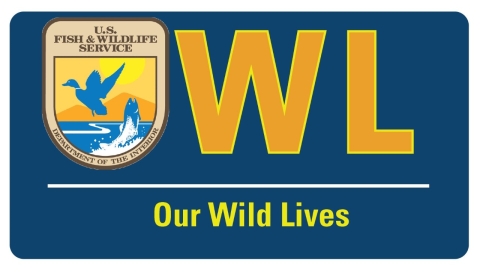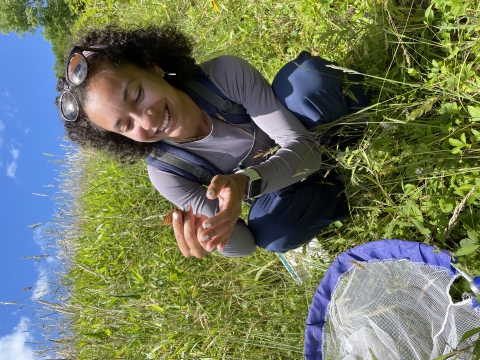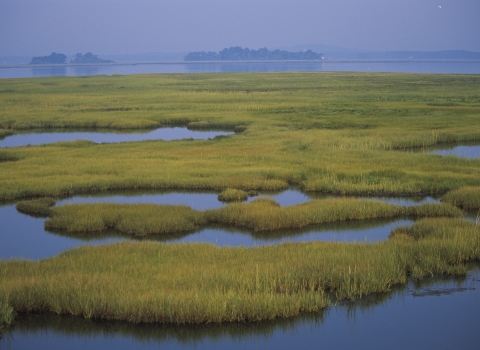“Describe your greatest strength.”
Employers often ask that of candidates during job interviews.
No doubt – if they could talk – bees would answer unanimously: organization. In the highly organized world of bees, each one understands its role, what fellow bees are doing, and how everyone contributes to the unit’s mission.
Organization is a trait sought after in the professional world. It keeps projects, and people, on track and increases productivity. It’s a skill important to pollinators, like bees, and those who study them, like biologists with the U.S. Fish and Wildlife Service.
This summer, Sharon Dorsey, a graduate student at Virginia Tech, brought her organizational skills to the Service. As part of the Directorate Fellows Program, she’s gathering information on all the Service’s pollinator conservation efforts conducted over the last two years throughout the Southeast region. Her field of study includes 10 states, Puerto Rico, and the U.S. Virgin Islands.
“Pollinator conservation actions, such as habitat restoration, recovery and outreach have occurred throughout the Southeast,” said Bryan Tompkins, a U.S. Fish and Wildlife Service biologist who helped guide Dorsey. “To date, there hasn't been a central repository for this data. This project has been created to try and uncover exactly what offices are prioritizing for pollinator conservation and the actions that are being implemented to meet those goals.”
Dorsey says connecting with individuals and building relationships with communities are among her strengths. In addition to organizational skills, these traits naturally complement her Pollinator Synthesis project.
“My project directly contributes to increased knowledge-sharing across offices in the Southeast and reducing instances of 're-inventing the wheel,’” Dorsey said. “Streamlining efforts and coordinating with others leads to more efficient conservation practices that effectively conserve, protect, and enhance wildlife and their habitats.”
While bees may be the first that come to mind, other pollinators include birds, bats, butterflies, moths, flies, wasps and beetles. Pollinators provide vital benefits to people and wildlife. Conserving pollinators and their habitat help protect lands and waters, and, deliver natural solutions to the changing climate.
Although tiny in size, they are hugely important – so much so that some pollinators have special consideration under the Endangered Species Act. Now in its 50th year, the Endangered Species Act provides a critical safety net for federally listed pollinators fish, wildlife, and plant. The act has prevented the extinction of hundreds of imperiled species, promoted the recovery of many others, and conserved the habitats upon which they depend.
“Pollinator populations, particularly bees and butterflies, are in decline, and coordinated conservation efforts will be required if we are to stymie the loss of pollinator abundance and diversity,” Tompkins said.
This is why the Pollinator Synthesis project is important to the Service. Dorsey will use information gathered about what’s being done, by whom, by species, and how successful the efforts have been tracking pollinator preservation, protection and progress. The tool will inform biologists’ current and future efforts across the entire region.
“This will allow all of us working on pollinator conservation in the Southeast to share ideas and lessons learned and will create more opportunities for coordination and collaboration as we collectively work to protect pollinators and their habitats across the landscape,” Tompkins said.
Thanks to the Service’s Directorate Fellows Program, which employed Dorsey, biologists in the Southeast region can now develop a methodical approach to monitoring and recovering pollinators. The 11-week long internship pairs college students with researchers on national wildlife refuges. It also helps increase the diversity of the Service’s workforce by recruiting people of color and students from other underrepresented populations. Candidates may be hired directly within two years after completing the DFP and related college or graduate degree requirements.
While Dorsey may have been new to the DFP program, she has shared her talents with and learned from the Service since 2016, when she was an undergraduate student at George Mason University. During a community service project as a student-athlete, Dorsey met a Service human resources employee who shared information about the agency’s student programs. Dorsey participated in the Career Discovery Internship Program seven years ago and has been “hooked” ever since.
“Sharon was highly recommended by several personnel from other field offices that have worked with her in the past,” Tompkins said. “She is a great communicator, a creative thinker, and very organized in her work. “She brings a strong initiative and drive to succeed to her work every day which is exactly what we needed in a DFP to complete the Pollinator Synthesis project.”
Dorsey encourages other college students – regardless of major or field of study – to explore internship opportunities with the Service. She says having a non-science background may set candidates apart as conservation efforts require all skill sets, including writing, marketing and engineering.
“The individuals I worked with for my project are equally invested in connecting me with other Service colleagues that work in my field or region of interest,” Dorsey said. “I am very grateful for the outpouring of resources and professional advice I have received through this fellowship as well.”





